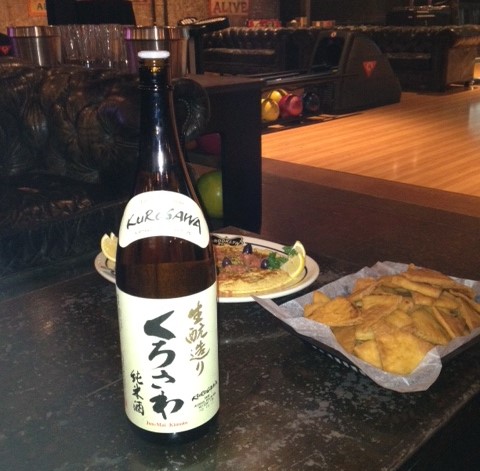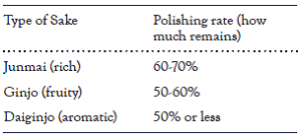
…and Onto Store Shelves
By Yoichi Nakajima
According to Japan National Tax Agency’s annual report, 4,489,281 liters of sake were imported to the United States from Japan in 2013. This equals approximately one million cases of sake, a whopping 15 percent increase from the previous year. On top of that, there are five major sake manufacturers right here, in the U.S. (four of them in California) producing ten times more “domestic sake” — although official statistics are unavailable. This is great news for rice growers in California.
You don’t have to go to a sushi bar to drink sake nowadays. A little background goes a long to help you sell to your customers. Ingredients:
Rice+Water+Koji+Yeast+Love=Sake
If you are not familiar with “koji,” its official name is Aspergillus oryzae. It is a type of mold or spore, which produces a variety of enzymes while growing on steamed rice. Unlike grapes, rice does not contain sugar. That’s why we need koji; it converts the starch of rice to sugar. The rest of the job will be done by yeast, the same as in wine-making.
Dry or Sweet?
Sake usually has no sign of “dry” or “sweet” on its label. However, if you look carefully at the back label, you may find SMV — which means “sake meter value.” Basically, it is a representation of the hydrometer to measure dryness of sake. In general, higher numbers (+5 or higher) represent “dry” and lower numbers (below zero) represent “sweet.”
Basic Classification of Sake:
It depends how much you polish off grain of rice.
Why do you have to polish rice? Because a grain of rice, especially the outer parts, contains protein, fat, vitamins, etc., which produce unwanted flavor. Shinpaku, or the core of a grain of rice, is genuine starch. Pure starch makes sake clean, aromatic and fruity. But polishing the rice to 50% or less takes more skill, time and cost. That’s why most daiginjo sakes are expensive.
Hot or Cold?
Most of the time, the hot sake served at Japanese restaurants is domestic (because it is much less expensive), and cold sake is an imported premium one. Certainly, premium sake, such as ginjo and daiginjo, are generally better served cold because of their delicate flavors and aromas. But if it’s not too aromatic, premium sake is great to enjoy as warm sake (not too hot). In cold winter when it is snowing outside, why don’t you enjoy warm sake? If you find yourself in the Arizona desert in August, you would do better to enjoy cold sake or icy beer!
My Top Ten
The following are the top ten sakes you can find and enjoy in the U.S., according to my preference and experience as a sake advisor working in the industry for 14 years. Most of them are premium imported sakes brewed in Japan, but American-made sake has been improving dramatically in terms of flavor and quality over the last ten years.
1. Kurosawa Junmai Kimoto (Kurosawa Brewery, Nagano, Japan)
Rice: Miyama Nishiki
Rice Polishing Rate: 65%
SMV: +2 (Medium Dry)
Do you remember Nagano Winter Olympics in 1998? Kurosawa Brewery, the highest-altitude brewery in Japan, is located at the foot of the Japanese Alps. It is the best place for sake making because of its cold, clean air, and snow-melt spring water. A rounded entry with an earthy, mediumbodied taste and creamy flavors, this traditional “Kimoto” style Junmai (pure-rice) sake pairs excellently with chicken and can be enjoy chilled, room temperature, or warm.
2. Kurosawa Nigori Sake (Kurosawa Brewery,
Nagao, Japan)
Rice: Nagano Rice
Rice Polishing Rate: 70%
SMV: -50 (Very Sweet)
Nigori literally means “cloudy” and it indicates “unfiltered sake.” A fruity nose and creamy flavor make it a complement to spicy foods, such as a Spicy Tuna Roll or Thai Curry.
3. Kenbishi Kuromatsu (Kenbishi Brewery, Hyogo, Japan)
Rice: Yamada Nishiki
Rice Polishing Rate: N/A
SMV: +0.5 (Medium Dry)
Kenbishi is the oldest sake brand (since 1505!). In the old days, Kenbishi was a very popular sake enjoyed by the samurai. On the eve of major battles, a large Kenbishi barrel would be ceremoniously opened to strengthen the bonds among all samurais. This is a versatile sake; you can enjoy Kenbishi cold, room temperature or warm. It is rich and full-bodied. You may want to pair this sake with Kobe-beef, uni (sea urchin) or ikura (salmon egg).
4. Katana Extra Dry (Hananomai Brewery,Shizuoka, Japan)
Rice: Gohyakumangoku
Rice Polishing Rate: 60%
SMV: +7 (Extra Dry)
Katana means “Japanese sword.” If you like dry sake, try this. Katana’s SMV is +7; it’s one of the driest sakes available in the U.S. Also, this sake is “Nama hozo,” which is freshly reserved with only one-time pasteurization (usually done twice). It goes well with strongly flavored dishes, such as fried chicken or roasted fish with spicy sauce.
5. Kawacho Junmai Ginjo (Nagai Brewery, Gunma, Japan)
Rice: Gohyakumangoku
Rice Polishing rate: 60%
SMV: +8 (Extra Dry)
Even dryer sake (SMV: +8), but well balanced with a gentle fragrance. “Kawacho” means “Stream of Fortune” or “Majestic River,” because the brewery is located near the source of Tone River, the longest river in Japan. Excellent with seafood.
6. Okunomatsu Ihei (Okunomatsu Brewery, Fukushima, Japan)
Rice: Yamada Nishiki
Rice Polishing Rate: 40%
SMV: +5 (Dry)
The flagship sake from Okunomatsu. The official name of the product is “Okunomatsu Juhachidai (18th Generation of Founder), Ihei Shizukuzake (Drip Filtered Sake).” Extremely high-end and a very limited production. You may find this sake only at exclusive restaurants in New York or Las Vegas. It could cost $1,000 per bottle at restaurants.
7. Shichiken Junmai Ginjo (Yamanashi Meijo, Yamanashi, Japan)
Rice: Miyama Nishiki
Rice Polishing Rate: 55%
SMV: +4 (Dry)
Shichiken means “Seven Wise Men.” The brewery is located in Hakushu, one of 100 best spring water sources in Japan. Because of the availability of the best spring water, famous Suntory distilleries are also located there too. It goes well with Yakitori or Salmon Teriyaki.
8. Kikusui Junmai Ginjo (Kikusui Brewery, Niigata, Japan)
Rice: Gohyakumangoku
Rice Polishing Rate: 55%
SMV: +1 (Medium Dry)
Niigata sake is famous for its lightness and dryness. Kikusui is one of the most popular brands among all Niigata sake. It goes well with lightly flavor food such as sashimi.
9. Hatsumago Junmai (Tohoku Meijo, Yamagata, Japan)
Rice: Miyama Nishiki
Rice Polishing Rate: 60%
SMV: +2 (Medium Dry)
Hatsumago literally means “first born grandchild.” This sake is made by the Kimoto method, a traditional way of sake making that includes a time-consuming, labor intensive process. The Kimoto method results in a full-bodied rich taste and deep flavor. This method was the standard for 300 years, but it is rare today.
10. MU Junmai Daiginjo (Yaegaki Sake & Spirits, Hyogo, Japan)
Rice: Yamada Nishiki
Rice Polishing Rate: 50%
SMV: +1 (Medium Dry)
Daiginjo is the top of the line; at least 50% of each grain of rice has been polished off and the various brewing processes are handled with even more care and attention. It is lighter and more fragrant than the ginjo type. MU means “nothing (to compare)” in Japanese. Delicate and brilliantly aromatic character. Best served as an aperitif on its own.
I hope you get out from your safety zone and try something new. You may be surprised.
Yoichi Nakajima was born and raised in Sapporo, Japan. He has worked as the East Coast General Manager in a leading sake importer for nearly 20 years. Besides sake, “YO” loves dance and DJ.





